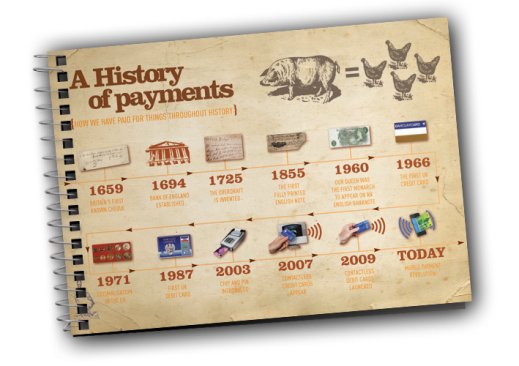Technological innovation in electronic payments is a constant factor throughout the history of electronic payment platforms.
The Diners Club Card, created in the 1950s, used in a private network of restaurants in New York, results from the vision of its founders Frank McNamara and Ralph Schneider, a view that has continued evolving both in the number of players (e.g. Amex launched a card in 1958 that could be used with traders in different activities) and also in the development of technology platforms and development in the cards themselves to ensure safety, simplicity and convenience of transactions, transversally across the world.
 Payments underwent various technological developments that should be recalled such as Automated Teller Machine (ATM 1967, used by plug or single-use coupon), the Automated Clearing House (ACH) which allowed the electronic transmission of funds between banks, the debit card (1975), the manual payment terminals used in the transactions involving credit cards (known as “ironing machines”), magnetic tape, Point of Sale (POS, 1979 – the date of the first payment transaction conducted by Visa), EMV chip (Europay, Mastercard, Visa, 1992), the pin code (personal identification number, in person), the 3D Secure protocol (transaction authentication code, online), the Contactless technologies and NFC (Near Field Communication), the generational evolution of the mobile network/wireless system – 2nd (1992), 3rd (2001), 4th (2012) and 5th (present), the Internet (2000), the Mobile Touch (Iphone, 2007 ) and the Internet of Things (IoT).
Payments underwent various technological developments that should be recalled such as Automated Teller Machine (ATM 1967, used by plug or single-use coupon), the Automated Clearing House (ACH) which allowed the electronic transmission of funds between banks, the debit card (1975), the manual payment terminals used in the transactions involving credit cards (known as “ironing machines”), magnetic tape, Point of Sale (POS, 1979 – the date of the first payment transaction conducted by Visa), EMV chip (Europay, Mastercard, Visa, 1992), the pin code (personal identification number, in person), the 3D Secure protocol (transaction authentication code, online), the Contactless technologies and NFC (Near Field Communication), the generational evolution of the mobile network/wireless system – 2nd (1992), 3rd (2001), 4th (2012) and 5th (present), the Internet (2000), the Mobile Touch (Iphone, 2007 ) and the Internet of Things (IoT).
Current technology allows a focus on a single computer chip device for processing, fast access storage capacity, software platforms and applications. The mobile incorporates multiple technological options such as GPS – Global Positioning System/Geolocation, Bluetooth, Contactless/NFC, SMS – Short Message Service/USSD – Unstructured Supplementary Service Data, QRCode – Quick Response Code – and Web- World Wide Web ( browser) and thus creates new ways to communicate (Apps) and to transact – M-Commerce, M-Payment, M-Wallet and even access to Social Commerce.
An additional note on contactless technology. In the form of stickers, prepaid devices or phones, contactless becomes increasingly popular as a means of payment due to its speed and convenience of service. We can see the examples of its use to streamline the payment of tolls in the United States (E-ZPass – a concept similar to the Portuguese system Via Verde) and the payment of public transport in London and Hong Kong (Oyster and Octopus, respectively).
The payments ecosystem changed radically at the time it became possible to initiate a payment without resorting to a bank account, whether by way of prepaid cards, or through the wallet, or via the mobile.
Traditionally, only the holder of a customer bank account and a cardholder could trigger a financial transaction.
The prepaid card allows the customer to use her/his card account to charge the card and make payments, without needing to open a bank account. This card is still, however, issued by the Issuing Bank/financial institution, subject to the rules of the national and/or international scheme (e.g. Visa, MasterCard, Amex).
The wallet allows customers to associate their cards in a virtual wallet facilitating the payment of the purchase online (the dematerialized card is used without the need for transmission and reintroduction of financial data to the merchant whenever a purchase is made) and of a physical purchase (the phone which initiates the transaction through an application, rather than the physical card that inserts into the merchant’s POS machine).
The wallets can also allow the creation of a virtual account associated to operate payments or transfers, which is fed, mostly, with funds from bank accounts which comply with the rules of compliance and of money laundering.
The performance of a financial transaction without using a bank account stimulated by new standards of digital consumer experience (here lies the innovation), saw many new players emerge in the ecosystem of payments, competitors of traditional banks not subject to regulation, with high negotiating power in the market, such as PayPal, the GAFA (Google, Apple, Facebook and Amazon), telecom operators (Deutshe Telecom, Telefónica, Vodafone), mobile phone manufacturers and major global retailers (Marks & Spencer, John Lewis Tesco, Wal-Mart).
What changes in the four-part Ecosystem?



[…] Payments Ecosystem 2/5 11/09/2016 […]
LikeLike
[…] Payments Ecosystem 2/5 11/09/2016 […]
LikeLike